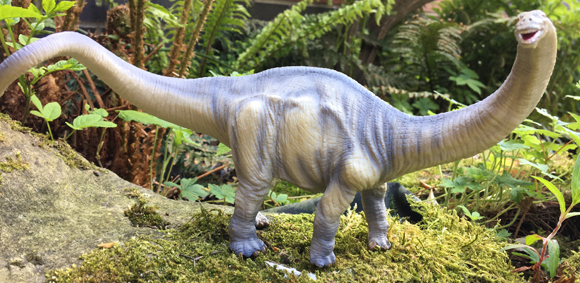New Study Suggests Facultative Bipedalism in Sauropods
Apatosaurus ajax – Speedy Sauropods
Every once in a while we come across a really well-written, concise summary of a scientific paper accompanied by a stunning image, illustrating the particular aspect of palaeontology under investigation. An example, of this can be seen below in a beautiful drawing interpreting a trace fossil found at the famous Morrison Formation site. We congratulate Matthew Mossbrucker (Director and Chief Curator at the Morrison Natural History Museum) and artist Fabio Pastori for their work.
Sauropod Dinosaurs
If science is the search for truth, then truth itself is of little use unless it can be communicated effectively. The example reproduced below regarding the analysis of trace fossils found at Quarry five in Morrison, Colorado (United States), demonstrates how to communicate studies in palaeontology to a wider audience.
The Search for Truth – A Brontosaurus Replica
Picture credit: Everything Dinosaur
The summation produced by Matthew Mossbrucker is reproduced below, he comments on the artwork created by Fabio Pastori:
“Speedy” the sauropod Apatosaurus ajax
A ajax running babies illustration by Fabio Pastori with scientific supervision and text by Matthew Mossbrucker.
This painting depicts a historic Morrison Formation site, Quarry 5 in Morrison, Colorado. Discovered by Arthur Lakes in the spring of 1877, this site is most significant because it produced the holotype of Stegosaurus armatus, Yale Peabody Museum specimen 1850. Sauropod remains have been documented at this site as well. Recent investigations at Quarry 5 yielded trace fossils on the top of the beds that contain the body fossils, including tracks likely made by juvenile and adult Apatosaurus ajax.
On a single ex situ boulder, juvenile sauropod trackways demonstrate two distinct footfall cadences – a near heel-toe hind track pattern, and a trackway that shows twice the amount of space (as compared to the aforementioned tracks) between footfalls in tracks the same size. This indicates that the two trackways represent distinct locomotion pattern: the closer footfalls a walking speed with the wider footfalls representing a low-speed ‘run.’ While the trackway of close footfalls does demonstrate relatively shallow, lunate manual tracks, the wider footfalls have no features representing manual tracks (either overstepped or not).
This suggests the possibility that young Apatosaurus had the capability of moving short distances bipedally.
Patient work at Quarry 5 is ongoing – hampered by very hard, silicic sandstone.
Congratulations to all involved in this fine marriage of scientific study and scientific illustration.
For models and replicas of sauropod dinosaur and other prehistoric creatures: Wild Safari Prehistoric World Models.


